SS4001 Social Work: Qualitative Evaluation Study Proposal on PATHS
VerifiedAdded on 2023/04/05
|13
|2373
|408
Report
AI Summary
This document presents a qualitative evaluation study proposal for the P.A.T.H.S. program, focusing on adolescents aged 6-7 with minor behavioral problems. The study aims to explore the perception of adolescents and implementers regarding curriculum-based youth development practices through focus groups and thematic analysis. The methodology includes a longitudinal qualitative evaluation with data collected from four schools, utilizing school social workers. The proposal outlines the conceptualization, operationalization, measurement, population sampling, data collection plan, and data analytic strategy. Ethical considerations such as anonymity and informed consent are addressed. Limitations of the study, including potential biases in focus group settings, are acknowledged. The research intends to provide further support for the effectiveness of social skill training programs based on pre-and-post-test design using P.A.T.H.S. to promote holistic development among adolescents in Hong Kong.

Student Name:
Student Number: Class Number:
Course Number & Name: SS4001 Social Work Practice Evaluation
Course Leader: Dr TY Lee
Title of Assignment:
Date and Time Due:
Tutorial Group: T01 T02 T03
Tutor’s Name:
Word Count: (excluding Appendices)
Student Declaration (must be read and signed)
By signing this, I declare that:
1. I have read the relevant Course Outline for this course, and this assignment meets all the requirements for the
course as detailed in the relevant Course Outline.
2. This assignment is original and has not been submitted for assessment elsewhere. I have conducted plagiarism
check using Turnitin. I attach the plagiarism check report. I confirm that the report is a true reflection of the final
version of my assignment.
3. I acknowledge that the assessor of this assignment may, for the purpose of assessment, reproduce and provide a
copy of this assignment to another member of faculty and/ or communicate a copy of this assignment to a
plagiarism checking service such as Turnitin (which may then retain a copy of this assignment on its database for
the purpose of future plagiarism checking).
4. Acknowledgement of source information is in accordance with guidelines and referencing style, i.e., the APA style,
as specified in the relevant Course Outline and/or assignment guidelines.
5. I am aware that late submission without an authorized extension from the Course Leader may result in a penalty as
specified in the Student Handbook on Late Submission of Assessment Tasks.
Student signature:
STUDENT RECEIPT – Please retain receipt. This is your only evidence of assignment submission.
Student Name:
Student Number:
Course Code: SS4001 Social Work Practice Evaluation
Assignment Title:
1
Student Number: Class Number:
Course Number & Name: SS4001 Social Work Practice Evaluation
Course Leader: Dr TY Lee
Title of Assignment:
Date and Time Due:
Tutorial Group: T01 T02 T03
Tutor’s Name:
Word Count: (excluding Appendices)
Student Declaration (must be read and signed)
By signing this, I declare that:
1. I have read the relevant Course Outline for this course, and this assignment meets all the requirements for the
course as detailed in the relevant Course Outline.
2. This assignment is original and has not been submitted for assessment elsewhere. I have conducted plagiarism
check using Turnitin. I attach the plagiarism check report. I confirm that the report is a true reflection of the final
version of my assignment.
3. I acknowledge that the assessor of this assignment may, for the purpose of assessment, reproduce and provide a
copy of this assignment to another member of faculty and/ or communicate a copy of this assignment to a
plagiarism checking service such as Turnitin (which may then retain a copy of this assignment on its database for
the purpose of future plagiarism checking).
4. Acknowledgement of source information is in accordance with guidelines and referencing style, i.e., the APA style,
as specified in the relevant Course Outline and/or assignment guidelines.
5. I am aware that late submission without an authorized extension from the Course Leader may result in a penalty as
specified in the Student Handbook on Late Submission of Assessment Tasks.
Student signature:
STUDENT RECEIPT – Please retain receipt. This is your only evidence of assignment submission.
Student Name:
Student Number:
Course Code: SS4001 Social Work Practice Evaluation
Assignment Title:
1
Paraphrase This Document
Need a fresh take? Get an instant paraphrase of this document with our AI Paraphraser
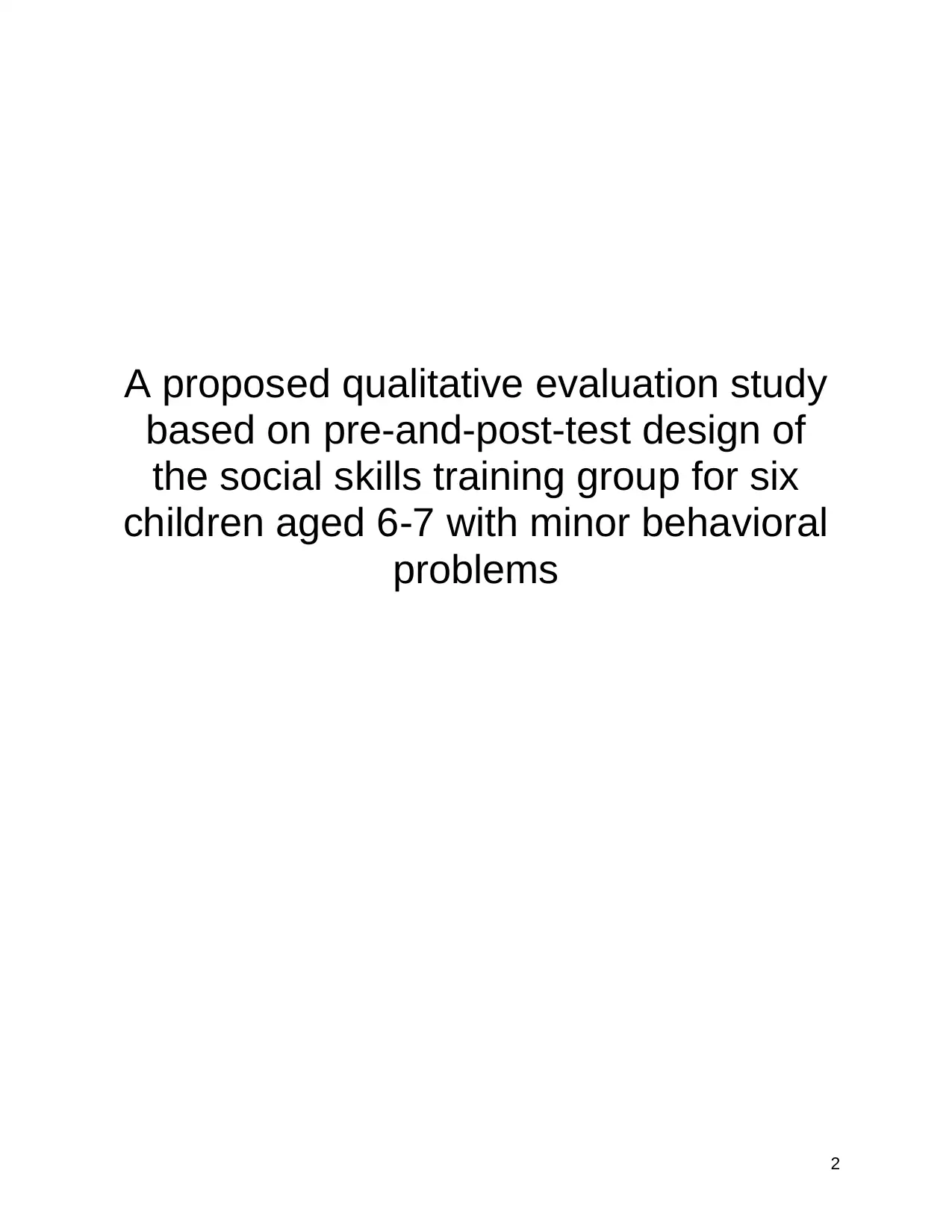
A proposed qualitative evaluation study
based on pre-and-post-test design of
the social skills training group for six
children aged 6-7 with minor behavioral
problems
2
based on pre-and-post-test design of
the social skills training group for six
children aged 6-7 with minor behavioral
problems
2
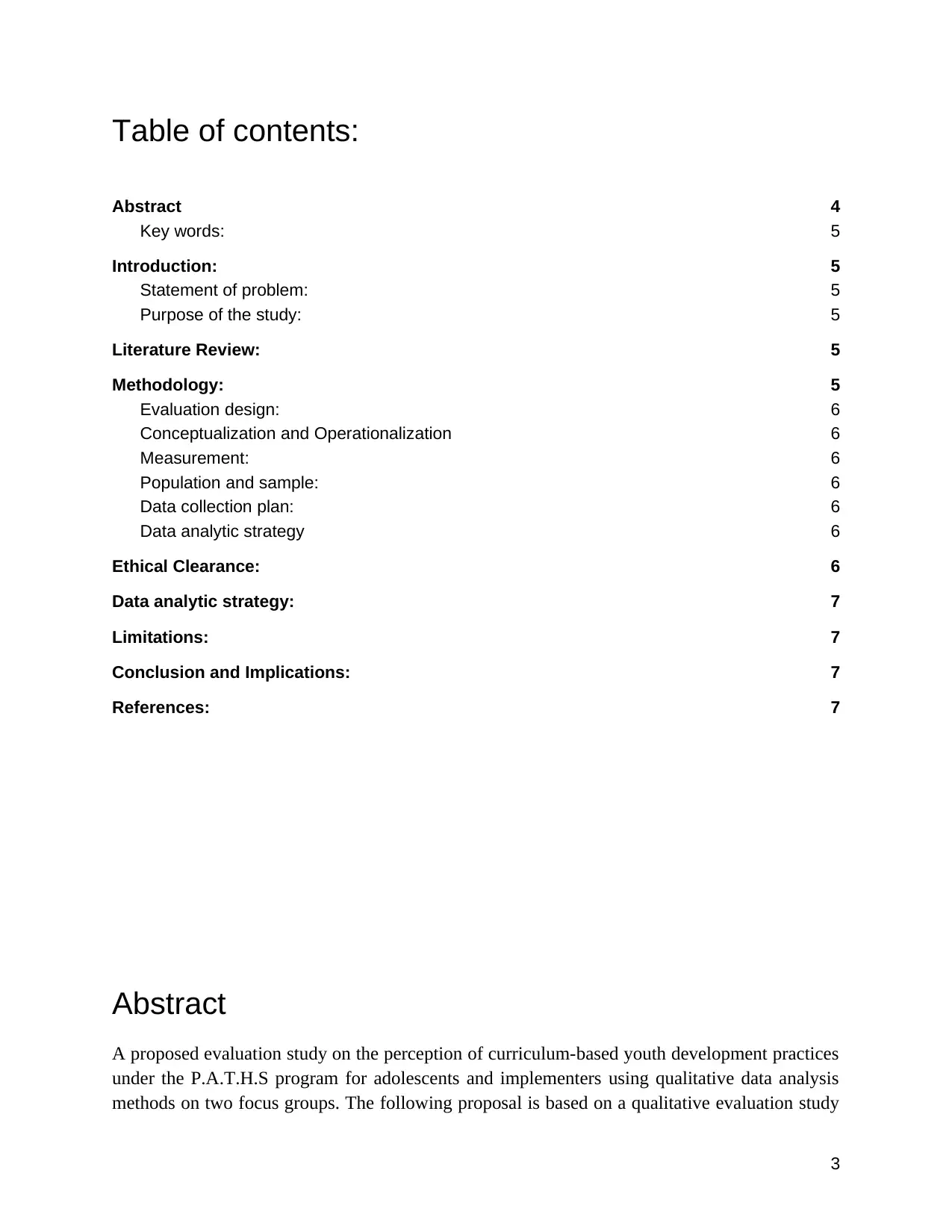
Table of contents:
Abstract 4
Key words: 5
Introduction: 5
Statement of problem: 5
Purpose of the study: 5
Literature Review: 5
Methodology: 5
Evaluation design: 6
Conceptualization and Operationalization 6
Measurement: 6
Population and sample: 6
Data collection plan: 6
Data analytic strategy 6
Ethical Clearance: 6
Data analytic strategy: 7
Limitations: 7
Conclusion and Implications: 7
References: 7
Abstract
A proposed evaluation study on the perception of curriculum-based youth development practices
under the P.A.T.H.S program for adolescents and implementers using qualitative data analysis
methods on two focus groups. The following proposal is based on a qualitative evaluation study
3
Abstract 4
Key words: 5
Introduction: 5
Statement of problem: 5
Purpose of the study: 5
Literature Review: 5
Methodology: 5
Evaluation design: 6
Conceptualization and Operationalization 6
Measurement: 6
Population and sample: 6
Data collection plan: 6
Data analytic strategy 6
Ethical Clearance: 6
Data analytic strategy: 7
Limitations: 7
Conclusion and Implications: 7
References: 7
Abstract
A proposed evaluation study on the perception of curriculum-based youth development practices
under the P.A.T.H.S program for adolescents and implementers using qualitative data analysis
methods on two focus groups. The following proposal is based on a qualitative evaluation study
3
⊘ This is a preview!⊘
Do you want full access?
Subscribe today to unlock all pages.

Trusted by 1+ million students worldwide
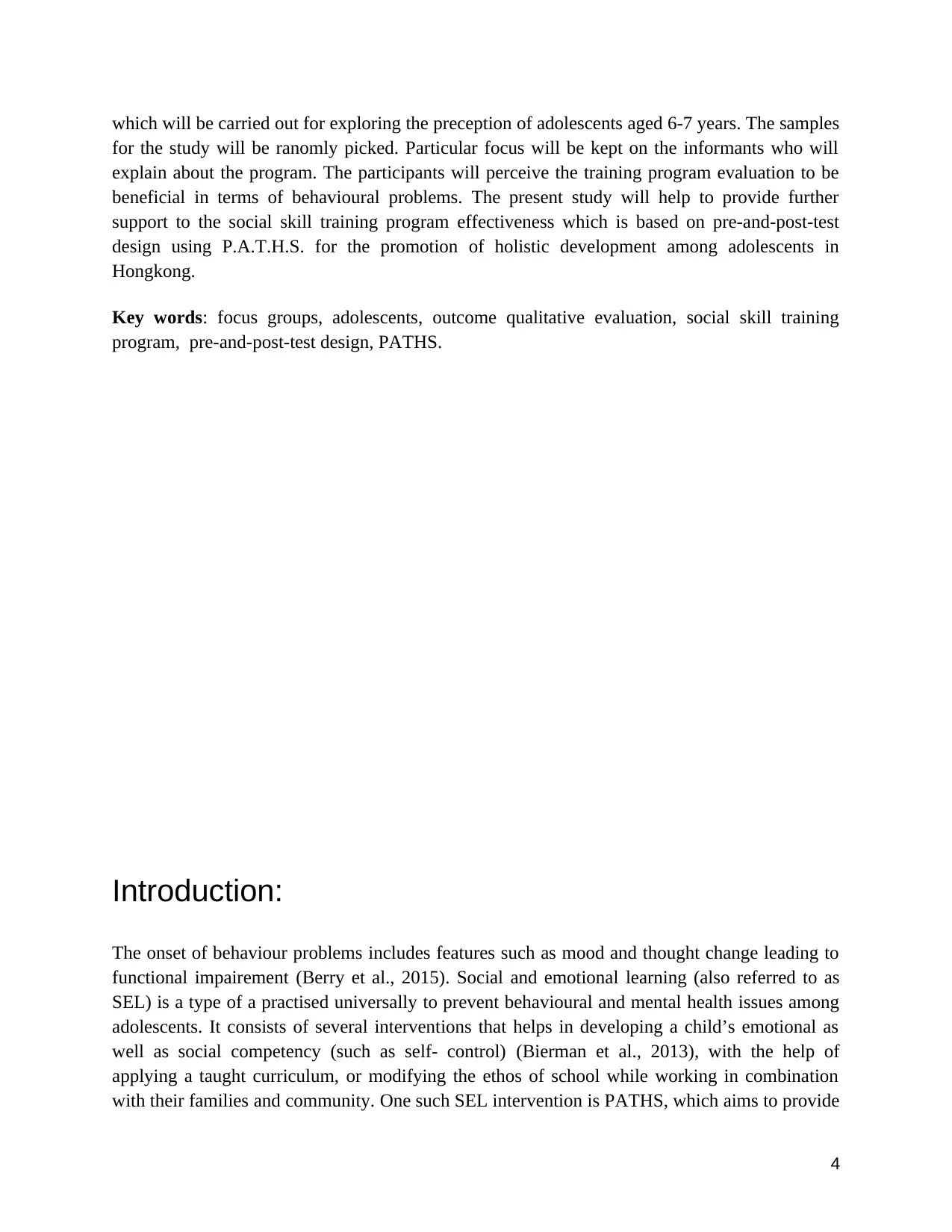
which will be carried out for exploring the preception of adolescents aged 6-7 years. The samples
for the study will be ranomly picked. Particular focus will be kept on the informants who will
explain about the program. The participants will perceive the training program evaluation to be
beneficial in terms of behavioural problems. The present study will help to provide further
support to the social skill training program effectiveness which is based on pre-and-post-test
design using P.A.T.H.S. for the promotion of holistic development among adolescents in
Hongkong.
Key words: focus groups, adolescents, outcome qualitative evaluation, social skill training
program, pre-and-post-test design, PATHS.
Introduction:
The onset of behaviour problems includes features such as mood and thought change leading to
functional impairement (Berry et al., 2015). Social and emotional learning (also referred to as
SEL) is a type of a practised universally to prevent behavioural and mental health issues among
adolescents. It consists of several interventions that helps in developing a child’s emotional as
well as social competency (such as self- control) (Bierman et al., 2013), with the help of
applying a taught curriculum, or modifying the ethos of school while working in combination
with their families and community. One such SEL intervention is PATHS, which aims to provide
4
for the study will be ranomly picked. Particular focus will be kept on the informants who will
explain about the program. The participants will perceive the training program evaluation to be
beneficial in terms of behavioural problems. The present study will help to provide further
support to the social skill training program effectiveness which is based on pre-and-post-test
design using P.A.T.H.S. for the promotion of holistic development among adolescents in
Hongkong.
Key words: focus groups, adolescents, outcome qualitative evaluation, social skill training
program, pre-and-post-test design, PATHS.
Introduction:
The onset of behaviour problems includes features such as mood and thought change leading to
functional impairement (Berry et al., 2015). Social and emotional learning (also referred to as
SEL) is a type of a practised universally to prevent behavioural and mental health issues among
adolescents. It consists of several interventions that helps in developing a child’s emotional as
well as social competency (such as self- control) (Bierman et al., 2013), with the help of
applying a taught curriculum, or modifying the ethos of school while working in combination
with their families and community. One such SEL intervention is PATHS, which aims to provide
4
Paraphrase This Document
Need a fresh take? Get an instant paraphrase of this document with our AI Paraphraser
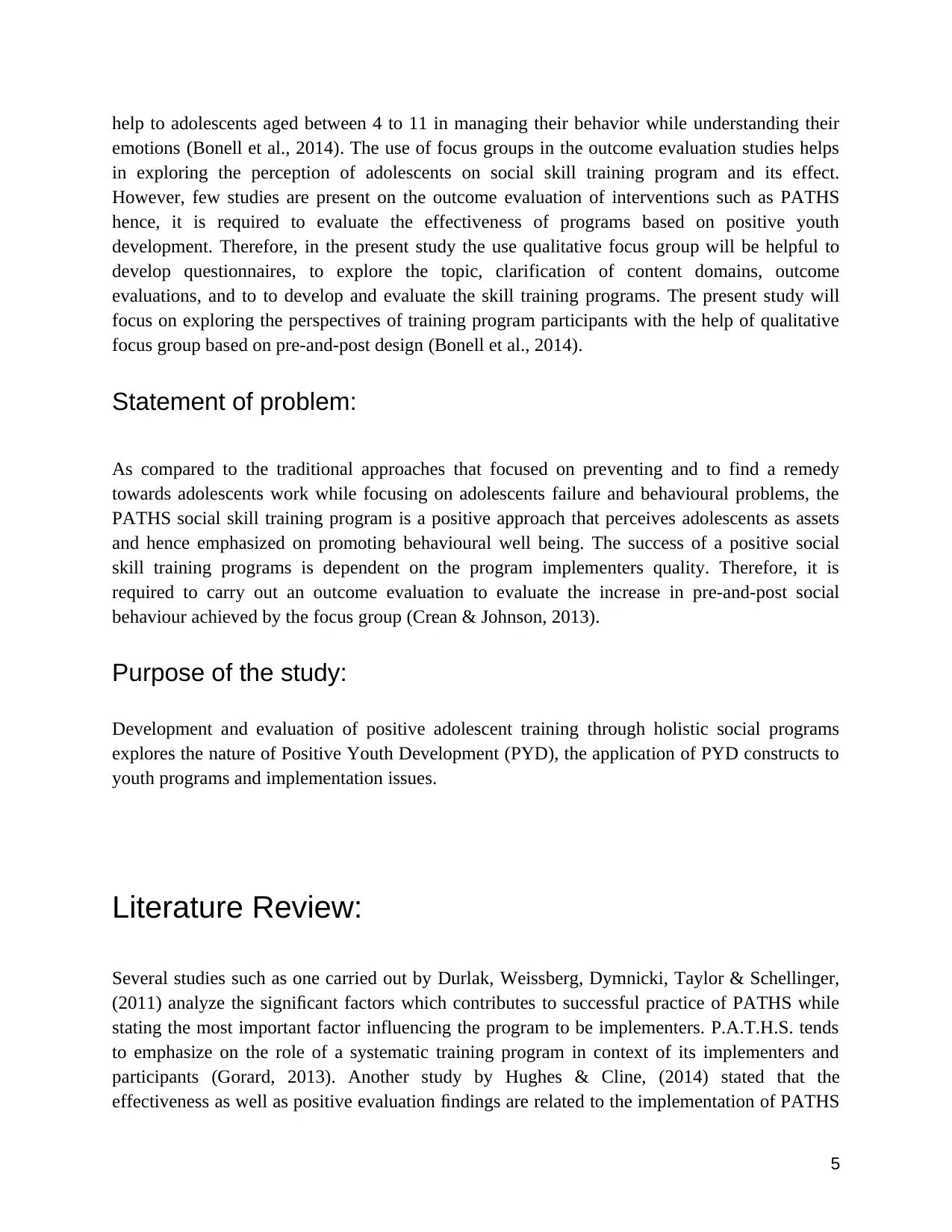
help to adolescents aged between 4 to 11 in managing their behavior while understanding their
emotions (Bonell et al., 2014). The use of focus groups in the outcome evaluation studies helps
in exploring the perception of adolescents on social skill training program and its effect.
However, few studies are present on the outcome evaluation of interventions such as PATHS
hence, it is required to evaluate the effectiveness of programs based on positive youth
development. Therefore, in the present study the use qualitative focus group will be helpful to
develop questionnaires, to explore the topic, clarification of content domains, outcome
evaluations, and to to develop and evaluate the skill training programs. The present study will
focus on exploring the perspectives of training program participants with the help of qualitative
focus group based on pre-and-post design (Bonell et al., 2014).
Statement of problem:
As compared to the traditional approaches that focused on preventing and to find a remedy
towards adolescents work while focusing on adolescents failure and behavioural problems, the
PATHS social skill training program is a positive approach that perceives adolescents as assets
and hence emphasized on promoting behavioural well being. The success of a positive social
skill training programs is dependent on the program implementers quality. Therefore, it is
required to carry out an outcome evaluation to evaluate the increase in pre-and-post social
behaviour achieved by the focus group (Crean & Johnson, 2013).
Purpose of the study:
Development and evaluation of positive adolescent training through holistic social programs
explores the nature of Positive Youth Development (PYD), the application of PYD constructs to
youth programs and implementation issues.
Literature Review:
Several studies such as one carried out by Durlak, Weissberg, Dymnicki, Taylor & Schellinger,
(2011) analyze the significant factors which contributes to successful practice of PATHS while
stating the most important factor influencing the program to be implementers. P.A.T.H.S. tends
to emphasize on the role of a systematic training program in context of its implementers and
participants (Gorard, 2013). Another study by Hughes & Cline, (2014) stated that the
effectiveness as well as positive evaluation findings are related to the implementation of PATHS
5
emotions (Bonell et al., 2014). The use of focus groups in the outcome evaluation studies helps
in exploring the perception of adolescents on social skill training program and its effect.
However, few studies are present on the outcome evaluation of interventions such as PATHS
hence, it is required to evaluate the effectiveness of programs based on positive youth
development. Therefore, in the present study the use qualitative focus group will be helpful to
develop questionnaires, to explore the topic, clarification of content domains, outcome
evaluations, and to to develop and evaluate the skill training programs. The present study will
focus on exploring the perspectives of training program participants with the help of qualitative
focus group based on pre-and-post design (Bonell et al., 2014).
Statement of problem:
As compared to the traditional approaches that focused on preventing and to find a remedy
towards adolescents work while focusing on adolescents failure and behavioural problems, the
PATHS social skill training program is a positive approach that perceives adolescents as assets
and hence emphasized on promoting behavioural well being. The success of a positive social
skill training programs is dependent on the program implementers quality. Therefore, it is
required to carry out an outcome evaluation to evaluate the increase in pre-and-post social
behaviour achieved by the focus group (Crean & Johnson, 2013).
Purpose of the study:
Development and evaluation of positive adolescent training through holistic social programs
explores the nature of Positive Youth Development (PYD), the application of PYD constructs to
youth programs and implementation issues.
Literature Review:
Several studies such as one carried out by Durlak, Weissberg, Dymnicki, Taylor & Schellinger,
(2011) analyze the significant factors which contributes to successful practice of PATHS while
stating the most important factor influencing the program to be implementers. P.A.T.H.S. tends
to emphasize on the role of a systematic training program in context of its implementers and
participants (Gorard, 2013). Another study by Hughes & Cline, (2014) stated that the
effectiveness as well as positive evaluation findings are related to the implementation of PATHS
5
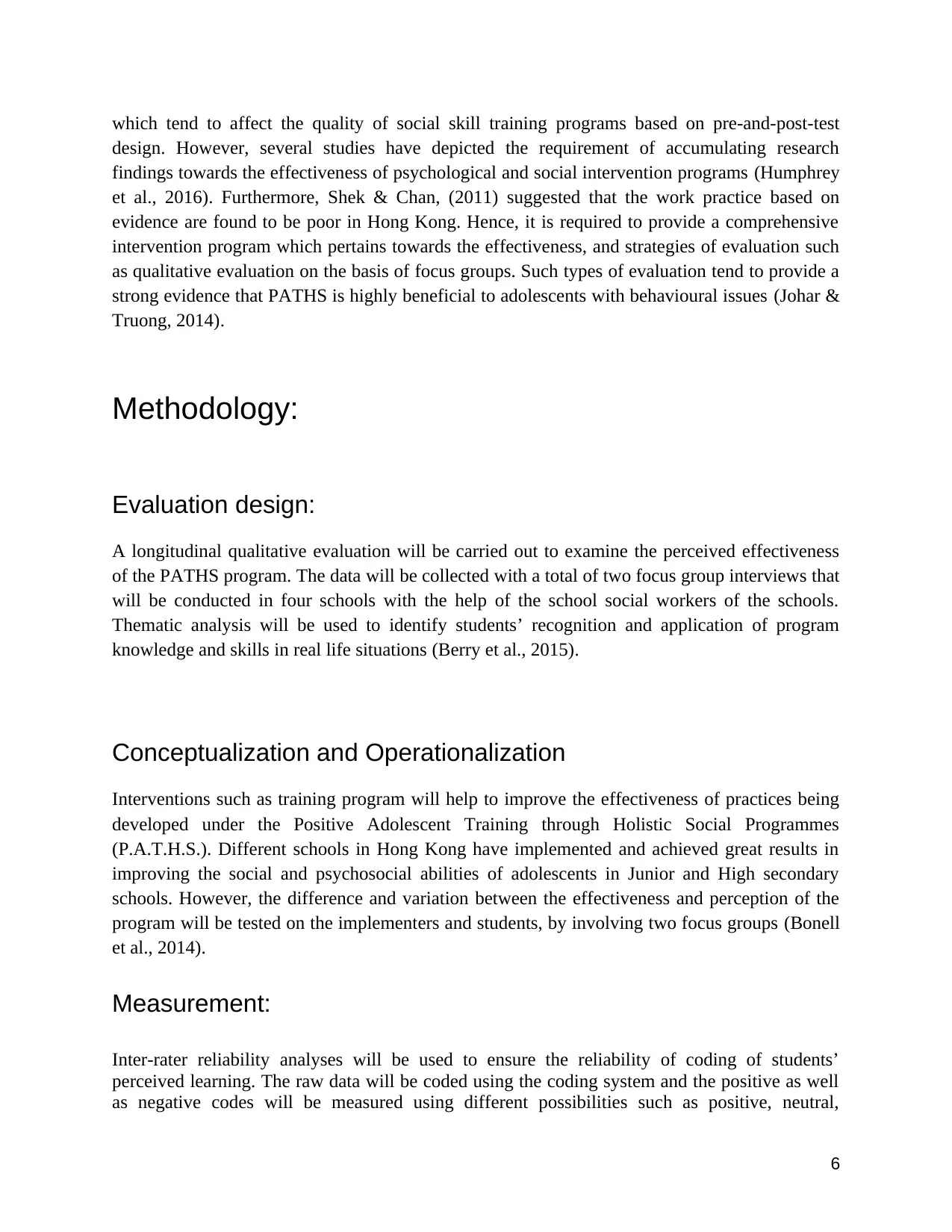
which tend to affect the quality of social skill training programs based on pre-and-post-test
design. However, several studies have depicted the requirement of accumulating research
findings towards the effectiveness of psychological and social intervention programs (Humphrey
et al., 2016). Furthermore, Shek & Chan, (2011) suggested that the work practice based on
evidence are found to be poor in Hong Kong. Hence, it is required to provide a comprehensive
intervention program which pertains towards the effectiveness, and strategies of evaluation such
as qualitative evaluation on the basis of focus groups. Such types of evaluation tend to provide a
strong evidence that PATHS is highly beneficial to adolescents with behavioural issues (Johar &
Truong, 2014).
Methodology:
Evaluation design:
A longitudinal qualitative evaluation will be carried out to examine the perceived effectiveness
of the PATHS program. The data will be collected with a total of two focus group interviews that
will be conducted in four schools with the help of the school social workers of the schools.
Thematic analysis will be used to identify students’ recognition and application of program
knowledge and skills in real life situations (Berry et al., 2015).
Conceptualization and Operationalization
Interventions such as training program will help to improve the effectiveness of practices being
developed under the Positive Adolescent Training through Holistic Social Programmes
(P.A.T.H.S.). Different schools in Hong Kong have implemented and achieved great results in
improving the social and psychosocial abilities of adolescents in Junior and High secondary
schools. However, the difference and variation between the effectiveness and perception of the
program will be tested on the implementers and students, by involving two focus groups (Bonell
et al., 2014).
Measurement:
Inter-rater reliability analyses will be used to ensure the reliability of coding of students’
perceived learning. The raw data will be coded using the coding system and the positive as well
as negative codes will be measured using different possibilities such as positive, neutral,
6
design. However, several studies have depicted the requirement of accumulating research
findings towards the effectiveness of psychological and social intervention programs (Humphrey
et al., 2016). Furthermore, Shek & Chan, (2011) suggested that the work practice based on
evidence are found to be poor in Hong Kong. Hence, it is required to provide a comprehensive
intervention program which pertains towards the effectiveness, and strategies of evaluation such
as qualitative evaluation on the basis of focus groups. Such types of evaluation tend to provide a
strong evidence that PATHS is highly beneficial to adolescents with behavioural issues (Johar &
Truong, 2014).
Methodology:
Evaluation design:
A longitudinal qualitative evaluation will be carried out to examine the perceived effectiveness
of the PATHS program. The data will be collected with a total of two focus group interviews that
will be conducted in four schools with the help of the school social workers of the schools.
Thematic analysis will be used to identify students’ recognition and application of program
knowledge and skills in real life situations (Berry et al., 2015).
Conceptualization and Operationalization
Interventions such as training program will help to improve the effectiveness of practices being
developed under the Positive Adolescent Training through Holistic Social Programmes
(P.A.T.H.S.). Different schools in Hong Kong have implemented and achieved great results in
improving the social and psychosocial abilities of adolescents in Junior and High secondary
schools. However, the difference and variation between the effectiveness and perception of the
program will be tested on the implementers and students, by involving two focus groups (Bonell
et al., 2014).
Measurement:
Inter-rater reliability analyses will be used to ensure the reliability of coding of students’
perceived learning. The raw data will be coded using the coding system and the positive as well
as negative codes will be measured using different possibilities such as positive, neutral,
6
⊘ This is a preview!⊘
Do you want full access?
Subscribe today to unlock all pages.

Trusted by 1+ million students worldwide

negative, and not decided (Crean & Johnson, 2013).
Population and sample:
Four schools will be selected for the random selection of participants from the same schools with
the help of social workers at the school. The sampling process will be based on random selection
of the schools and will be invited for participating in the focus group interviews. A total of 25
students will be selected to join the focus groups including further 10 informants in the focus
group (Hughes & Cline, 2014)
Data collection plan:
Qualitative methods that will be used in the study includes interviews, process evaluation forms,
and process implementation questionnaires that will be provided to the participants (Shek &
Chan, 2011).
Data analytic strategy
Focus groups involving program implementers based on schools randomly selected from the
participating schools were also conducted in the project. Secondary data analysis of the related
data that will be collected in the project will reveal several observations. First, the program
implementers will tend to identify strengths and positive features of the program. Second, they
will perceive the program to be beneficial to the development of the program participants. Third,
they will propose suggestions on how the program could be improved. Generally speaking, the
program implementers will be carrying out have positive evaluation of the program. Prominent
themes will be identified systematically based on the data obtained and the transcription-based
analysis will be carried out (Durlak, Weissberg, Dymnicki, Taylor & Schellinger, 2011).
Ethical Clearance:
Complete anonymity will be maintained (ethical considerations like consent, right to withdraw,
involving an unbiased researcher for data analysis). The study protocol will be carried out after
the approval of Ethical committee. The participants will be asked to join the study on a voluntary
basis by signing a consent form. A consent to publish the results will be taken from their parents
stating that the information that will be obtained from the study will be used for future research
while no revealing of the personal details of every child will be carried out (Johar & Truong,
2014).
7
Population and sample:
Four schools will be selected for the random selection of participants from the same schools with
the help of social workers at the school. The sampling process will be based on random selection
of the schools and will be invited for participating in the focus group interviews. A total of 25
students will be selected to join the focus groups including further 10 informants in the focus
group (Hughes & Cline, 2014)
Data collection plan:
Qualitative methods that will be used in the study includes interviews, process evaluation forms,
and process implementation questionnaires that will be provided to the participants (Shek &
Chan, 2011).
Data analytic strategy
Focus groups involving program implementers based on schools randomly selected from the
participating schools were also conducted in the project. Secondary data analysis of the related
data that will be collected in the project will reveal several observations. First, the program
implementers will tend to identify strengths and positive features of the program. Second, they
will perceive the program to be beneficial to the development of the program participants. Third,
they will propose suggestions on how the program could be improved. Generally speaking, the
program implementers will be carrying out have positive evaluation of the program. Prominent
themes will be identified systematically based on the data obtained and the transcription-based
analysis will be carried out (Durlak, Weissberg, Dymnicki, Taylor & Schellinger, 2011).
Ethical Clearance:
Complete anonymity will be maintained (ethical considerations like consent, right to withdraw,
involving an unbiased researcher for data analysis). The study protocol will be carried out after
the approval of Ethical committee. The participants will be asked to join the study on a voluntary
basis by signing a consent form. A consent to publish the results will be taken from their parents
stating that the information that will be obtained from the study will be used for future research
while no revealing of the personal details of every child will be carried out (Johar & Truong,
2014).
7
Paraphrase This Document
Need a fresh take? Get an instant paraphrase of this document with our AI Paraphraser
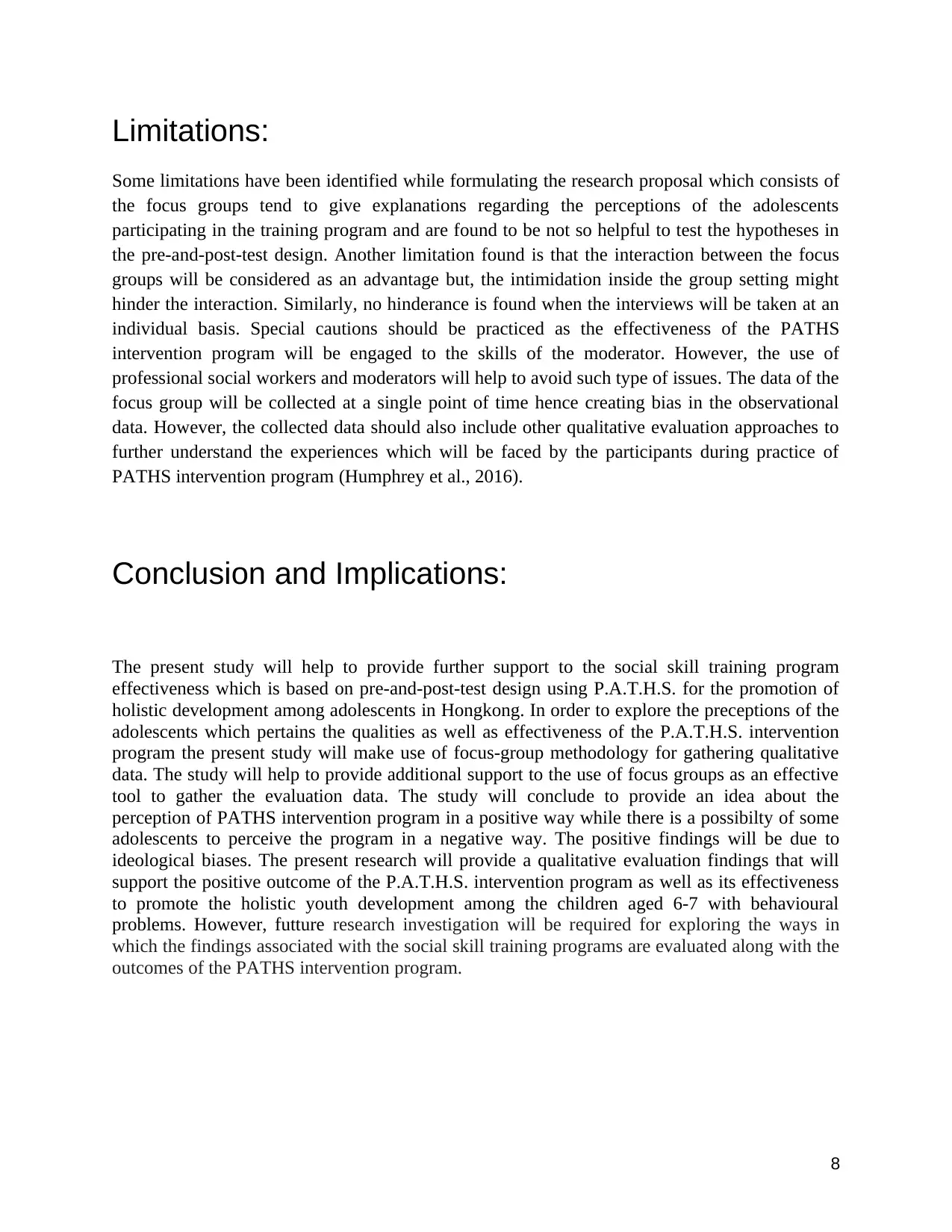
Limitations:
Some limitations have been identified while formulating the research proposal which consists of
the focus groups tend to give explanations regarding the perceptions of the adolescents
participating in the training program and are found to be not so helpful to test the hypotheses in
the pre-and-post-test design. Another limitation found is that the interaction between the focus
groups will be considered as an advantage but, the intimidation inside the group setting might
hinder the interaction. Similarly, no hinderance is found when the interviews will be taken at an
individual basis. Special cautions should be practiced as the effectiveness of the PATHS
intervention program will be engaged to the skills of the moderator. However, the use of
professional social workers and moderators will help to avoid such type of issues. The data of the
focus group will be collected at a single point of time hence creating bias in the observational
data. However, the collected data should also include other qualitative evaluation approaches to
further understand the experiences which will be faced by the participants during practice of
PATHS intervention program (Humphrey et al., 2016).
Conclusion and Implications:
The present study will help to provide further support to the social skill training program
effectiveness which is based on pre-and-post-test design using P.A.T.H.S. for the promotion of
holistic development among adolescents in Hongkong. In order to explore the preceptions of the
adolescents which pertains the qualities as well as effectiveness of the P.A.T.H.S. intervention
program the present study will make use of focus-group methodology for gathering qualitative
data. The study will help to provide additional support to the use of focus groups as an effective
tool to gather the evaluation data. The study will conclude to provide an idea about the
perception of PATHS intervention program in a positive way while there is a possibilty of some
adolescents to perceive the program in a negative way. The positive findings will be due to
ideological biases. The present research will provide a qualitative evaluation findings that will
support the positive outcome of the P.A.T.H.S. intervention program as well as its effectiveness
to promote the holistic youth development among the children aged 6-7 with behavioural
problems. However, futture research investigation will be required for exploring the ways in
which the findings associated with the social skill training programs are evaluated along with the
outcomes of the PATHS intervention program.
8
Some limitations have been identified while formulating the research proposal which consists of
the focus groups tend to give explanations regarding the perceptions of the adolescents
participating in the training program and are found to be not so helpful to test the hypotheses in
the pre-and-post-test design. Another limitation found is that the interaction between the focus
groups will be considered as an advantage but, the intimidation inside the group setting might
hinder the interaction. Similarly, no hinderance is found when the interviews will be taken at an
individual basis. Special cautions should be practiced as the effectiveness of the PATHS
intervention program will be engaged to the skills of the moderator. However, the use of
professional social workers and moderators will help to avoid such type of issues. The data of the
focus group will be collected at a single point of time hence creating bias in the observational
data. However, the collected data should also include other qualitative evaluation approaches to
further understand the experiences which will be faced by the participants during practice of
PATHS intervention program (Humphrey et al., 2016).
Conclusion and Implications:
The present study will help to provide further support to the social skill training program
effectiveness which is based on pre-and-post-test design using P.A.T.H.S. for the promotion of
holistic development among adolescents in Hongkong. In order to explore the preceptions of the
adolescents which pertains the qualities as well as effectiveness of the P.A.T.H.S. intervention
program the present study will make use of focus-group methodology for gathering qualitative
data. The study will help to provide additional support to the use of focus groups as an effective
tool to gather the evaluation data. The study will conclude to provide an idea about the
perception of PATHS intervention program in a positive way while there is a possibilty of some
adolescents to perceive the program in a negative way. The positive findings will be due to
ideological biases. The present research will provide a qualitative evaluation findings that will
support the positive outcome of the P.A.T.H.S. intervention program as well as its effectiveness
to promote the holistic youth development among the children aged 6-7 with behavioural
problems. However, futture research investigation will be required for exploring the ways in
which the findings associated with the social skill training programs are evaluated along with the
outcomes of the PATHS intervention program.
8
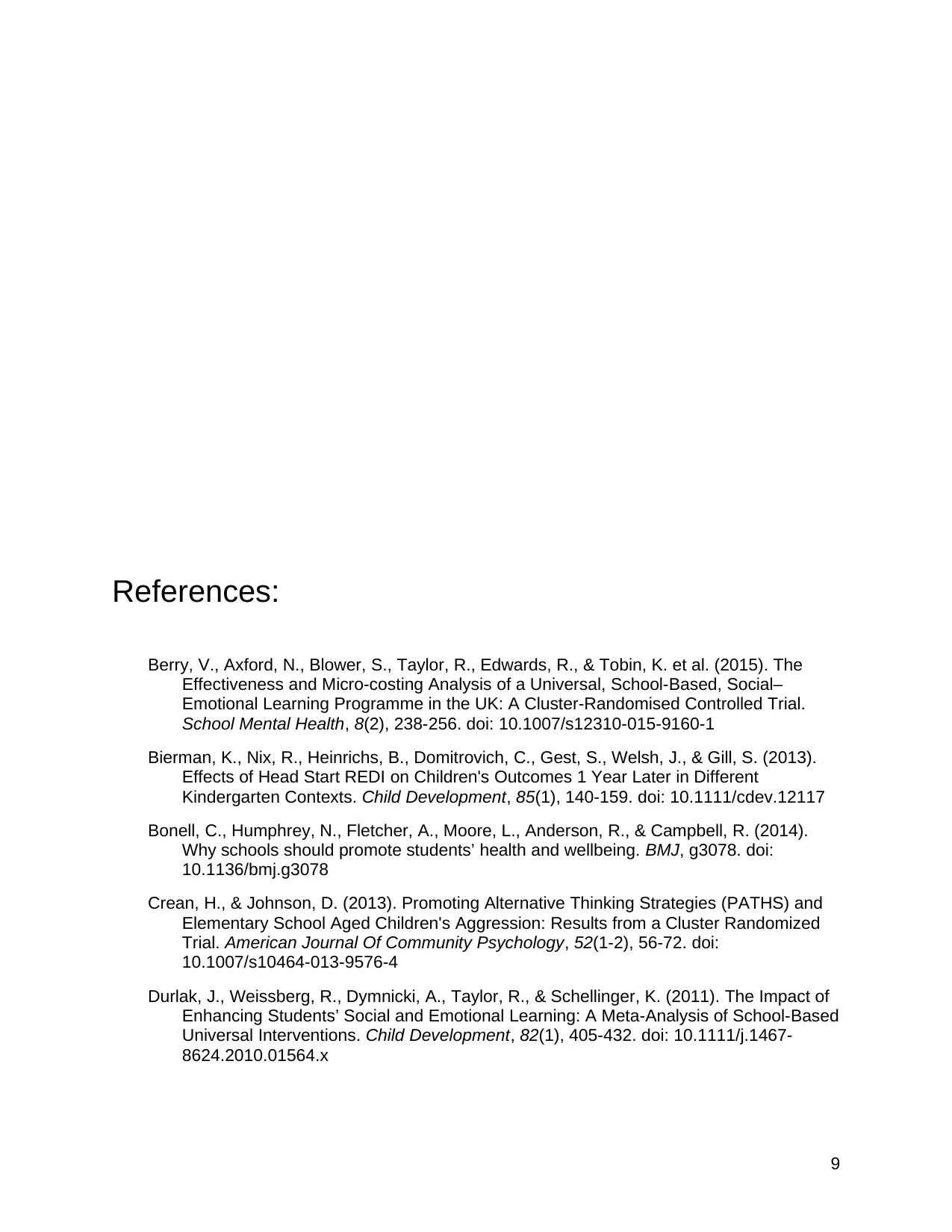
References:
Berry, V., Axford, N., Blower, S., Taylor, R., Edwards, R., & Tobin, K. et al. (2015). The
Effectiveness and Micro-costing Analysis of a Universal, School-Based, Social–
Emotional Learning Programme in the UK: A Cluster-Randomised Controlled Trial.
School Mental Health, 8(2), 238-256. doi: 10.1007/s12310-015-9160-1
Bierman, K., Nix, R., Heinrichs, B., Domitrovich, C., Gest, S., Welsh, J., & Gill, S. (2013).
Effects of Head Start REDI on Children's Outcomes 1 Year Later in Different
Kindergarten Contexts. Child Development, 85(1), 140-159. doi: 10.1111/cdev.12117
Bonell, C., Humphrey, N., Fletcher, A., Moore, L., Anderson, R., & Campbell, R. (2014).
Why schools should promote students’ health and wellbeing. BMJ, g3078. doi:
10.1136/bmj.g3078
Crean, H., & Johnson, D. (2013). Promoting Alternative Thinking Strategies (PATHS) and
Elementary School Aged Children's Aggression: Results from a Cluster Randomized
Trial. American Journal Of Community Psychology, 52(1-2), 56-72. doi:
10.1007/s10464-013-9576-4
Durlak, J., Weissberg, R., Dymnicki, A., Taylor, R., & Schellinger, K. (2011). The Impact of
Enhancing Students’ Social and Emotional Learning: A Meta-Analysis of School-Based
Universal Interventions. Child Development, 82(1), 405-432. doi: 10.1111/j.1467-
8624.2010.01564.x
9
Berry, V., Axford, N., Blower, S., Taylor, R., Edwards, R., & Tobin, K. et al. (2015). The
Effectiveness and Micro-costing Analysis of a Universal, School-Based, Social–
Emotional Learning Programme in the UK: A Cluster-Randomised Controlled Trial.
School Mental Health, 8(2), 238-256. doi: 10.1007/s12310-015-9160-1
Bierman, K., Nix, R., Heinrichs, B., Domitrovich, C., Gest, S., Welsh, J., & Gill, S. (2013).
Effects of Head Start REDI on Children's Outcomes 1 Year Later in Different
Kindergarten Contexts. Child Development, 85(1), 140-159. doi: 10.1111/cdev.12117
Bonell, C., Humphrey, N., Fletcher, A., Moore, L., Anderson, R., & Campbell, R. (2014).
Why schools should promote students’ health and wellbeing. BMJ, g3078. doi:
10.1136/bmj.g3078
Crean, H., & Johnson, D. (2013). Promoting Alternative Thinking Strategies (PATHS) and
Elementary School Aged Children's Aggression: Results from a Cluster Randomized
Trial. American Journal Of Community Psychology, 52(1-2), 56-72. doi:
10.1007/s10464-013-9576-4
Durlak, J., Weissberg, R., Dymnicki, A., Taylor, R., & Schellinger, K. (2011). The Impact of
Enhancing Students’ Social and Emotional Learning: A Meta-Analysis of School-Based
Universal Interventions. Child Development, 82(1), 405-432. doi: 10.1111/j.1467-
8624.2010.01564.x
9
⊘ This is a preview!⊘
Do you want full access?
Subscribe today to unlock all pages.

Trusted by 1+ million students worldwide
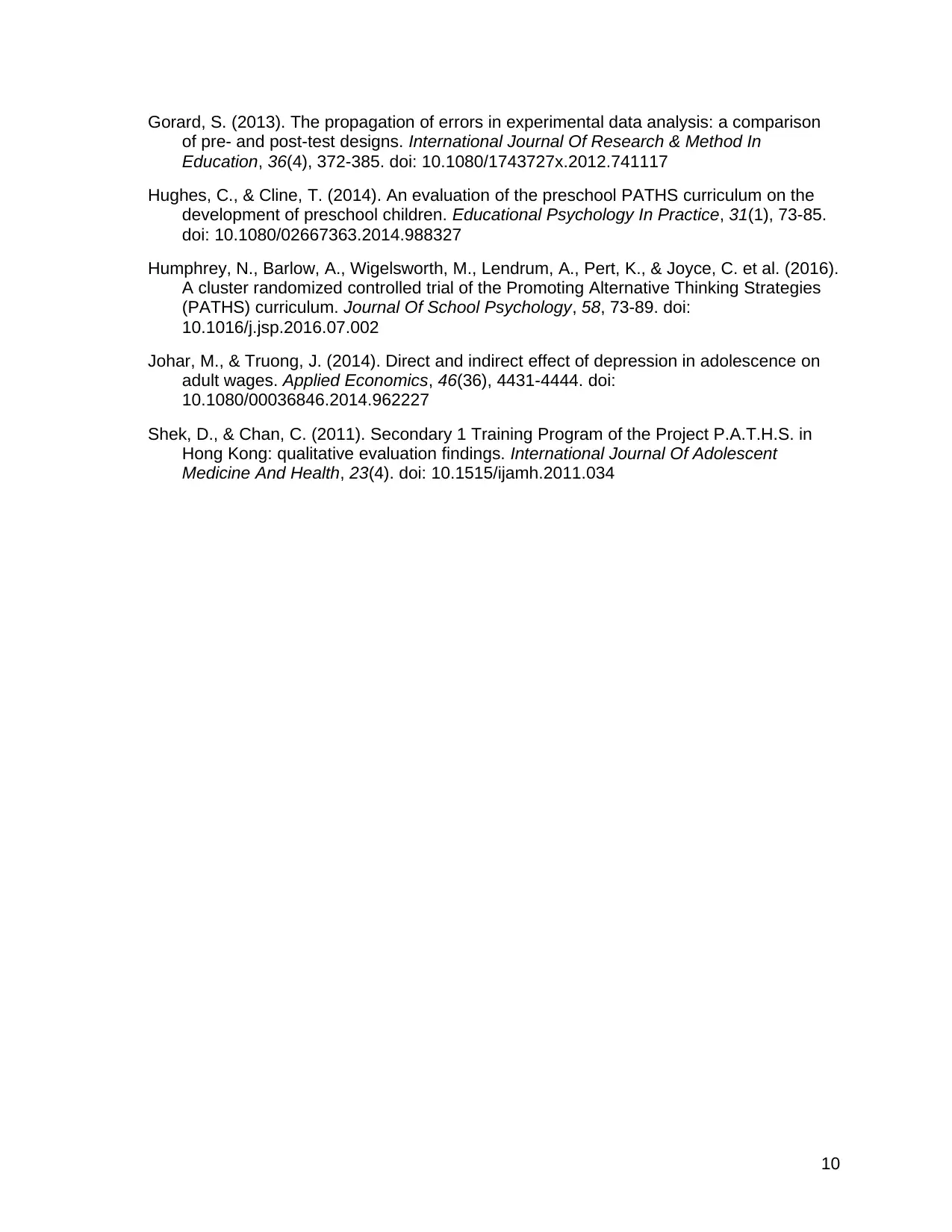
Gorard, S. (2013). The propagation of errors in experimental data analysis: a comparison
of pre- and post-test designs. International Journal Of Research & Method In
Education, 36(4), 372-385. doi: 10.1080/1743727x.2012.741117
Hughes, C., & Cline, T. (2014). An evaluation of the preschool PATHS curriculum on the
development of preschool children. Educational Psychology In Practice, 31(1), 73-85.
doi: 10.1080/02667363.2014.988327
Humphrey, N., Barlow, A., Wigelsworth, M., Lendrum, A., Pert, K., & Joyce, C. et al. (2016).
A cluster randomized controlled trial of the Promoting Alternative Thinking Strategies
(PATHS) curriculum. Journal Of School Psychology, 58, 73-89. doi:
10.1016/j.jsp.2016.07.002
Johar, M., & Truong, J. (2014). Direct and indirect effect of depression in adolescence on
adult wages. Applied Economics, 46(36), 4431-4444. doi:
10.1080/00036846.2014.962227
Shek, D., & Chan, C. (2011). Secondary 1 Training Program of the Project P.A.T.H.S. in
Hong Kong: qualitative evaluation findings. International Journal Of Adolescent
Medicine And Health, 23(4). doi: 10.1515/ijamh.2011.034
10
of pre- and post-test designs. International Journal Of Research & Method In
Education, 36(4), 372-385. doi: 10.1080/1743727x.2012.741117
Hughes, C., & Cline, T. (2014). An evaluation of the preschool PATHS curriculum on the
development of preschool children. Educational Psychology In Practice, 31(1), 73-85.
doi: 10.1080/02667363.2014.988327
Humphrey, N., Barlow, A., Wigelsworth, M., Lendrum, A., Pert, K., & Joyce, C. et al. (2016).
A cluster randomized controlled trial of the Promoting Alternative Thinking Strategies
(PATHS) curriculum. Journal Of School Psychology, 58, 73-89. doi:
10.1016/j.jsp.2016.07.002
Johar, M., & Truong, J. (2014). Direct and indirect effect of depression in adolescence on
adult wages. Applied Economics, 46(36), 4431-4444. doi:
10.1080/00036846.2014.962227
Shek, D., & Chan, C. (2011). Secondary 1 Training Program of the Project P.A.T.H.S. in
Hong Kong: qualitative evaluation findings. International Journal Of Adolescent
Medicine And Health, 23(4). doi: 10.1515/ijamh.2011.034
10
Paraphrase This Document
Need a fresh take? Get an instant paraphrase of this document with our AI Paraphraser

Appendices
Appendix I: Client Background Information
Diagnostic criteria
Age
Sex
Comorbidity
Socio-demographics
Country/Ethnicity
Co-medication
Appendix II: Ethical Review of Evaluation Research Involving Human Participants
11
Appendix I: Client Background Information
Diagnostic criteria
Age
Sex
Comorbidity
Socio-demographics
Country/Ethnicity
Co-medication
Appendix II: Ethical Review of Evaluation Research Involving Human Participants
11

Appendix III: Detailed Intervention Plan
Appendix IV: All Measurement Tools.
12
Appendix IV: All Measurement Tools.
12
⊘ This is a preview!⊘
Do you want full access?
Subscribe today to unlock all pages.

Trusted by 1+ million students worldwide
1 out of 13
Related Documents
Your All-in-One AI-Powered Toolkit for Academic Success.
+13062052269
info@desklib.com
Available 24*7 on WhatsApp / Email
![[object Object]](/_next/static/media/star-bottom.7253800d.svg)
Unlock your academic potential
Copyright © 2020–2025 A2Z Services. All Rights Reserved. Developed and managed by ZUCOL.





